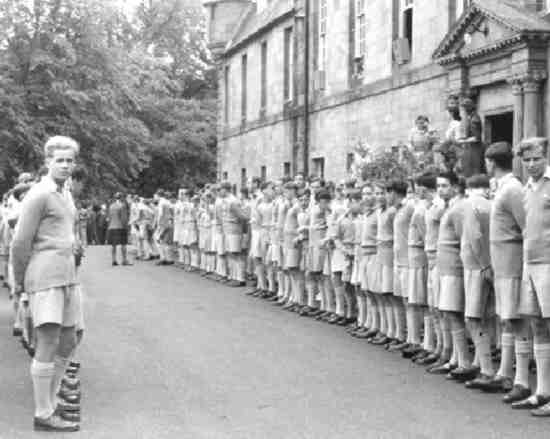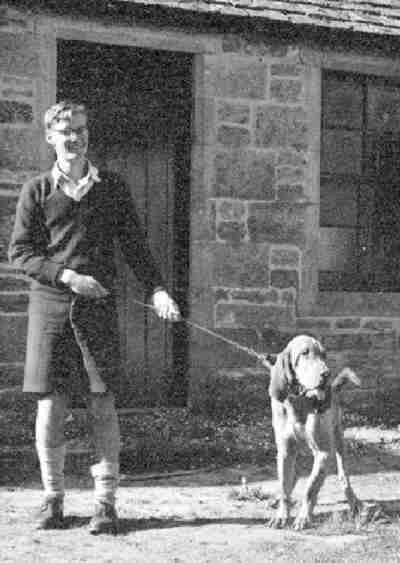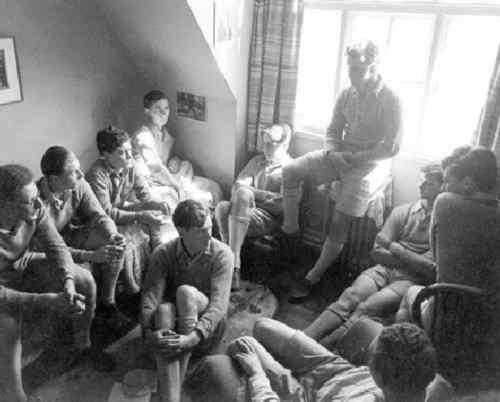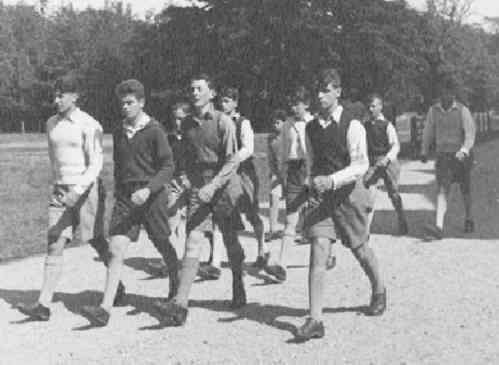
Figure 1.--This formation of the Gordonstoun students shows the everyday uniform that the boys wore in the 1950s. The boys wear tan jumpers, shirt trousers, and kneesocks with brown lace up shoes. A few boys wore sandals. Note the open neck shirts.


Figure 1.--This formation of the Gordonstoun students shows the everyday uniform that the boys wore in the 1950s. The boys wear tan jumpers, shirt trousers, and kneesocks with brown lace up shoes. A few boys wore sandals. Note the open neck shirts. |
One of the most famous school in Scotland is Gordonstoun. The school interestingly was founded by Kurt Hann, a German who believed in providing a challenging physical as well as educational experience. Added to the normal challenging sport program of a British chool was a novel new outward bound aexoeriences. Hann also believe in community service. Gordonstoun was also the public (private secondary) school chosen for Prince Charles.
Gordonstoun School located near Elgin in northern Scotland. It was founded as a boys' boarding school, but is now coeducational and has both boarding and day pupils. The religious affiliation is Christian, but is inter denominational. The school is, like most British schools, run on the basis of the house system. The current houses are: Altyre House, Bruce House, Cumming House, Duffus House, Hopeman House, Plewlands House, Round Square, and Windmill Lodge.

Figure 2.--Some images show the boys wearing dark jumpers and short trousers. I'm not sure what the difference is between this and the lighter uniform. |
A German educator founded what is probably today the most well known school in Scotland. Germany's excellent education system was one of the first targets of the NAZIs who wanted to titally control the formation of young minds. Educators who were not pro-NAZI or willing to go along with the NAZI program were forced out. One such eductor was Dr. Kurt Hahn, Headmaster of Salem School. (HBC is not sure what the educational program or uniform of the Salem School was, but hopto leearn more about this.) Dr. Mann not willing to accept NAZI control of the education program left Germany and founded founded an "international" boys' boarding school in the far north of Scotland.
Dr. Hann had some novel ideas about education. He perceived an increasing decay in contemporary society. He sought to combat that decay by promoting in his students qualities of skill, compassion, honesty, initiative, adventure and service to their fellow beings. While academics were important, he sought to develop the "whole person" which he felt was accomplished by building a school community made up of boys of differing backgounds, talents and interests.
Hahn wanted a rural setting to provide grounds to pursue his educational ideras. He found an imposing estate in the temperate environment of Morayshire. He launched his new school with only a handful of boys and two historic buildings, Gordonstoun House and Round Square.
Dr. Hahn slowly expanded the enrollment as word of the educational program spread. The school faced many challenges, not the least being World War II. The school was evacuated to Llandinam . (Many British schools were moved during the War, especially schools located along the coast.) When the school returned after the War, tey found a fire ravaged Gordonstoun House. By this time the school had become so well known that Queen Elizabeth and Prince Phillip chose the school for Prince Charles in the 1950s. The school changed to coeducation in 1972.

Figure 3.--The boys participated in the running of the school community. |
One ot the reasons for private education is for parents to be able to chose a school with an education approach that belive most meets the needs of their child. The Gordonstoun's philosphy that the full boarding environment is the best way to promote the program. The school believes that everyone is good at something. The stuents have to make some choices. To do nothing is not an option. The school seeks to challenge and stretch every individual, providing numerous opportunities for the novice, the cheerful participant and the expert.
HBC does not know what was adopted as the original school uniform. The Gordonstoun uniform by the 1950s was a rather informal one, in keeping with the school's active sports and outdoor program. The boys wore open neck shirts with tan jumpers, short trousers, and kneesocks. Boys wore both short an long sleeved jumpers. Some images show the boys wearing dark jumpers and short trousers. I'm not sure what the difference is between this and the lighter uniform. All boys wore short trousers, all year round. Most boys wore tan lace up shoes, but sandals were allowed. The dress uniform was a tweed jacket and kilt. A former student has provided some details on this. He tells us, "The two colours of uniform in Gordonston were "Morning Uniform" and "Afternoon
Uniform". The "Afternoon Uniform" was navy blue, and the "Morning Uniform" was a light silvery grey-blue.The shorts were a hard wearing woolen cloth with button flies, a single pocket at the rear, and no lining. At some point first the "Afternoon Uniform" was dropped."

Figure 4.--The Gordonstoun program included a great variety of outdoor activities. Notice the variety of jumpers that the boys are wearing. |
The uniform has since changed, I'm not sure when. It is now a blue jumper and black long trousers, still worn with white open necked shirts. A former student tells us, "The shorts were
replaced by black polyester trousers. The remaining uniform was (is) still called "Morning Uniform" although it was worn all day." The dress uniform is still a tweed jacket and kilt.
Kurt Hahn after World war II established Arbelour House in 1947. Arbelour House was a preparatory school. This mean a school to prepare boys for their public (private secondary) school. Many but not all of the boys from Arbelour House went on to Gordonstoun. The program at Arbelour House was designed to prepare boys for the rigourous life at Gordonstoun. Aberlour House originally used the same uniforms as it was the prep school for Gordonstoun. At some point they dropped the "Morning Uniform" and replaced the
wollen shorts with the corduroy ones.
Related Chronolgy Pages in the Boys' Historical Web Site
[The 1880s]
[The 1930s]
[The 1940s]
[The 1950s]
[The 1960s]
[The 1970s]
[The 1980s]
